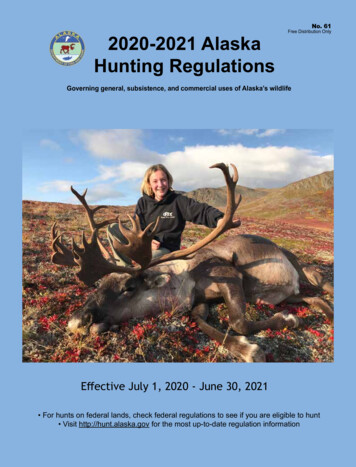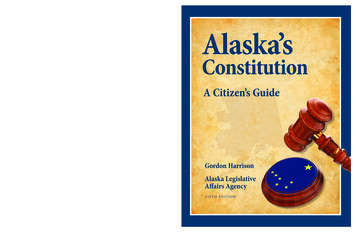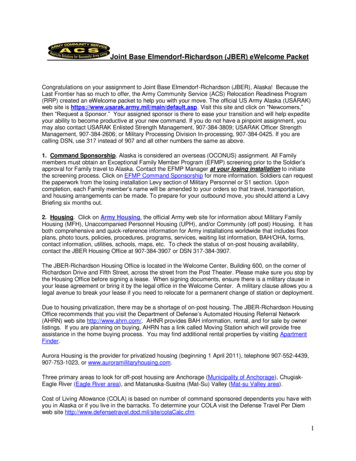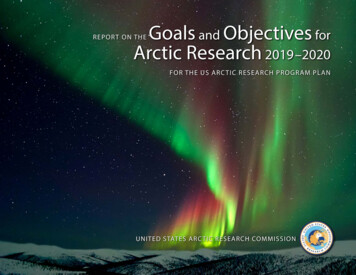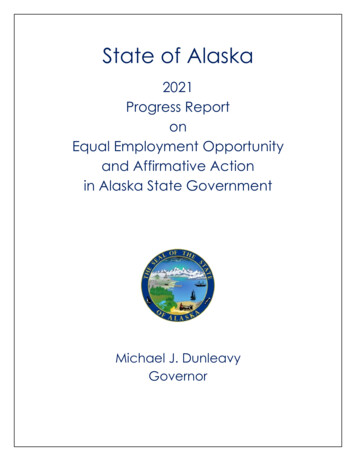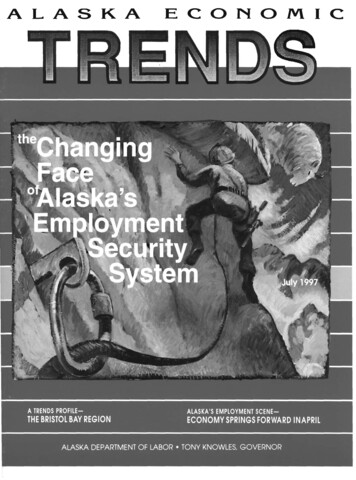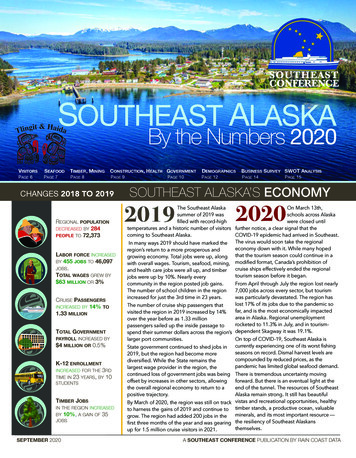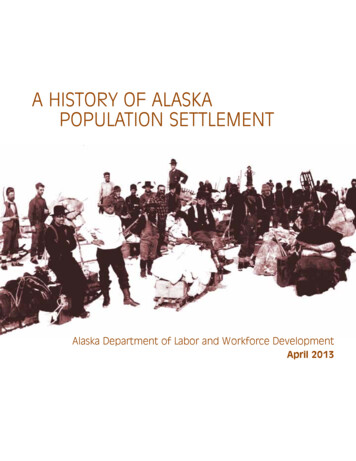
Transcription
A HISTORY OF ALASKAPOPULATION SETTLEMENTAlaska Department of Labor and Workforce DevelopmentApril 2013
A HISTORY OF ALASKAPOPULATION SETTLEMENTPrepared by:ERIC SANDBERG, Research AnalystContributors:EDDIE HUNSINGER, State DemographerSARA WHITNEY, EditorResearch and Analysis SecƟon,Alaska Department of Labor and Workforce Development,Division of AdministraƟve Serviceslaborstats.alaska.govOn the cover: Pioneers on the trail at Chilkoot Pass during the KlondikeGold Rush, 1898. Photo courtesy of Alaska State Library Historical Collec ons,Winter and Pond.
Table of ContentsThe First Alaskans . . . . . . . . . . . . .Russian America . . . . . . . . . . . . .Early American Alaska . . . . . . . . . . .Gold Rush Era . . . . . . . . . . . . . .Interwar Period. . . . . . . . . . . . . .World War II and the Cold War Militariza on .North Slope Crude and the Oil Boom and BustAlaska Since 1990 . . . . . . . . . . . . .Summary . . . . . . . . . . . . . . . .References. . . . . . . . . . . . . . . . 4. 6. 8. 9.10.12.13.14.18.19A HISTORY OF ALASKA POPULATION SETTLEMENT3
Alaska has the longest history of humanhabita on and se lement of any placein the Americas. Throughout that history, the state’s se lement has beenshaped primarily by geography, fur, fish, gold,railroads, oil, war, and military strategy.These factors directly influenced the se lementpa erns of Alaska and how popula on centerswaxed and waned over me. Examples are dotted throughout history, from the growth anddecline of gold rush boomtowns like Nome andSkagway to the Trans-Alaska Oil Pipeline bringingin the oil economy with its price-based fluctuaons.Presen ng a concise history of Alaska’s se lement and its es to popula on sta s cs is noteasy — the topic is one that could fill severalbooks, and each era is marked by widely different levels of data availability. Many importanthistorical moments are not evident in populaon numbers, and some large changes cannotbe readily explained. S ll, looking at Alaska history through popula on se lement numbersprovides context for much of the state’s transforma on.Tracing Alaska’s se lement begins with theindigenous peoples before contact with Europeans, through Russian America and the U.S. Purchase, followed by the Gold Rush, World War II,the Cold War, the oil boom and bust, and to themodern day.The popula on data come from several sources, primarily U.S. Census records that havebeen released every 10 years since 1880 forAlaska. Early censuses also included overviewsof all counts conducted during the RussianAmerica me period. Several books and academic publica ons, listed at the end, providedes mates and historical narra ve. Finally, allrounded popula on numbers are approximate.THE FIRST ALASKANSAnthropologists have long surmised that theroute of human migra on from Asia intoNorth America came through Alaska. The Bering4A HISTORY OF ALASKA POPULATION SETTLEMENTMany Na ve groups lived seminomadic lifestyles, staying in onespot over the winter and travelinggreat distances to hunt and fish insummer.Strait, the 53 mile-wide channel that separatesthe two con nents, was an open plain crossableon foot during the Ice Age. The exact nature ofthis migra on has been a controversial scholarlydebate, however. Hypotheses have differed onthe route taken, whether over land through theBering Land Bridge or by sea through the Aleuan Islands.Whether there was one large migra on or threemigra ons at different me periods is also a matter of con nuing debate and research. One lineof thinking focuses on one migra on from Asiafrom which all indigenous peoples of the Americas descend. Another is that several waves ofmigra ons spanned thousands of years, with different groups within Alaska arriving at differentmes. According to this hypothesis, the ancestors of Athabascans and Tlingit groups arrived inAlaska in an earlier migra on than the ancestorsof Aleuts and Eskimos. (Vadja)Surveying the landscape of Alaska before European contact reveals se lement not altogetherdifferent from the larger Alaska Na ve regionsof the state today. Many of the past villageswere in coastal regions or along the great rivers of the interior of Alaska. Many groups livedsemi-nomadic lifestyles, staying in one spotover the winter and traveling great distances tohunt and fish in summer.UAA anthropology professor Steve Langdon esmates that approximately 80,000 people livedin Alaska by the me of contact with Europeans,which began in the mid-1700s. (See Figure 1.)This popula on number was not reached againun l World War II.All numbers presented in this sec on are Langdon’s es mated values at the point of contactwith Europeans (defined as the first significantdirect interac on) that he published in his
Figure 1: Map of different Na ve groups with pre-contact popula ons (Langdon)before contact.book The NaƟve People of Alaska, numbersthat are used by the Alaska Na ve HeritageCenter in Anchorage.Prior to first contact, 15,000 people lived inSoutheast, the realm of the Tlingit. The largestcongrega ons resided near the S kine Riverclose to Wrangell and the Chilkat River nearHaines, both close to routes through the mountains. In addi on to the Tlingit, around 1,800Haida lived on the southern half of Prince ofWales Island. Haida were based primarily inmodern-day Bri sh Columbia, but their rangecrossed into Alaska.Around the Gulf of Alaska, the Alu iq were thedominant group. Around 2,000 Alu iq lived inthe Prince William Sound area and an addi onal 1,500 resided along the coastal Kenai Peninsula and Alaska Peninsula. However, the centerof Alu iq culture was Kodiak Island, home tobetween 12,000 and 15,000 people. One of thelargest se lement areas was the Karluk Riveron the western side of Kodiak Island. This salmon-rich river likely had around 1,800 people living nearby, making it among the most populouscommunity or set of communi es in AlaskaAlong the Aleu an Islands, west of Port Moller,lived the Unangan people. Commonly referredto by their Russian name “Aleut,” they likelynumbered between 15,000 and 18,000 for theen re island chain. According to Langdon, Unangan numbers are more difficult to es matebecause they were the first to come into contact with Europeans and suffered overwhelming popula on loss a erward.North of the Aleu ans, the Yupik people occupied the lower regions and deltas of the Yukonand Kuskokwim rivers, plus the area aroundBristol Bay. This, the most populous Alaska Nave area of the state today, had around 19,500Yupiit at first contact. Of this total, most —13,500 — lived in the Yukon-Kuskokwim Deltaregion and on Nunivak Island. Another 3,000lived around Bristol Bay. The remaining groupswere either along Norton Sound (1,500) or onSt. Lawrence Island (1,500). A large village nearthe site of Gambell was likely home to 500-600residents.Inupiat along the northern coastal regions wereA HISTORY OF ALASKA POPULATION SETTLEMENT5
among the last groups to encounter Europeans.Coastal villages with abundant resources had amore sta onary year-round popula on, whileinland Inupiat were nomadic. Large concentraons of people lived in strategic coastal spotssuch as modern-day Wales, Point Hope, andBarrow. The Kotzebue Sound region had thelargest popula on at 4,000. Nearly 3,500 people lived up along the North Slope, 1,500 on theSeward Peninsula, and 1,000 on the offshoreBering Strait islands.The inland Athabascan people lived mostlyalong the rivers of the interior. Totaling 11,000people, many Athabascan groups movedaround to several fishing and hun ng campsper year in search of food. The Dena’ina grouparound Cook Inlet numbered 3,000 people,and the Ahtna group in the Copper River valleynumbered 1,000. Most other Athabascans livedalong the Yukon/Kuskokwim/Tanana river watersheds. The groups closer to the modern-dayboundary with Canada numbered 2,200, whilethe groups farther downriver numbered 4,800.RUSSIAN AMERICAThe first foray of Europeans into Alaska wasthe voyage of Danish explorer Vitus Bering,who reached Alaska in 1741 on behalf of thetsar of Russia. Soon other European na onssuch as Spain and Great Britain began sendingvessels through Alaska’s coastal waters, but itwas the Russians who claimed the land, hunting for furs and bringing the Russian OrthodoxChurch with them. (See Figure 2.)The tsar made this claim official in 1799 with aukase (decree) gran ng the newly formed Russian-American Company exclusive trading rightsand judicial power over the Aleu ans and NorthAmerica above 55 degrees la tude. (Later treaes and commissions would set Alaska’s exactboundary.)On maps of that me period, Russia was in controlof the en re landmass that became Alaska, but intruth their direct control varied from heavy-handed to nonexistent. (Borneman) In the Aleu ans,the Unangans were subjugated by force and madeto hunt sea o ers for the Russian fur trade. Otherareas, including the Arc c region and inland rivers6A HISTORY OF ALASKA POPULATION SETTLEMENTRussia was in control of the en relandmass that became Alaska, butin truth their direct control variedfrom heavy-handed to nonexistent.areas, saw li le if any Russian presence.While the Russians did not extensively se leAlaska, their coming had a devasta ng effecton the indigenous popula on. Disease broughtfrom Europe ravaged the local popula on.Many epidemics swept through during theRussian America period, including dysentery,influenza, typhoid, whooping cough, andmeasles. The most deadly epidemic was thesmallpox outbreak from 1835 to 1840, whichstruck hardest in Southeast Alaska and Kodiak. Few medical personnel were sta oned inthe colony and vaccines were in short supply,worsening the crisis. (Gibson)The total popula on loss of Alaska Na ves fromall causes during the Russian America period isunknown. Es mates are 80 percent of the Aleutand Koniag (Kodiak) popula ons and 50 percentof the Chugach (Prince William Sound), Tlingit,Haida, and Dena’ina popula ons. (Langdon)During the en re period of Russian coloniza on,there was no a empt at a complete census, fora couple of reasons. First, the Russian footprintremained minimal to nonexistent in severalareas of Alaska, including much of the arc cand upriver areas of the Yukon Basin. The otherreason is that many of the censuses were conducted by the Russian-Orthodox Church, whichonly counted believers.S ll, several popula on counts were made inRussian America by the church and RussianAmerican Company. Early counts of Kodiak Island in the late 18th century placed the populaon at 6,000. The first large scale enumera onordered in 1819 counted 14,019 people in Russian America, 391 of whom were Russian. Thiscount did not include anyone in interior, arc c,or western Alaska north of the Alaska Peninsula.Several smaller es mates of Alaska Na ves followed in subsequent years, including an es mate of 5,850 Tlingit in 1835.
Figure 2: Map of principal Russian se lements during the Russian America periodFather Ioann Veniaminov, a Russian Orthodoxmissionary and scholar who later became Bishop Innocent, produced an es mate of 39,813people for Russian America in 1839. No ceablyhigher than other Russian counts and es mates, Veniaminov surmised that beyond thoseareas known, 17,000 people had not beencontacted yet. He es mated 7,000 people livedalong the Kuskokwim River and 5,000 Tlingitlived in Southeast, the most populated areas inAlaska. He put the total number of Russians at706, with 1,295 “Creoles,” or those born of Russian and Na ve parents.Before the sale of Alaska, Russian-AmericanCompany popula on numbers compiled from1830 to 1863 show Alaska’s popula on rangedbetween 11,022 and 7,224. Though the es mates of Alaska Na ves were low, the reportalso listed the peak Russian popula on in theterritory at 823 in 1839.During the Russian America period, severalse lements formed the center of Russian lifein the colony. The earliest Russian se lementwas a fur trading post at Unalaska, foundedin the 1770s following ba les with the Aleutsalready living on the island. (Gates) AlexanderBaranof, a fur trader and later governor, established two important Russian se lements.In 1791, he moved the Russian se lement onsouthwest Kodiak Island at Three Saints Bay tothe site of modern-day Kodiak. Baranof laterfounded New Archangel (Sitka) in 1804, following a ba le with the local Tlingit. New Archangel became the capital and administra vecenter of Russian-America as well as the mostpopulous Russian se lement.By the 1860s, tsarist Russia was seeking a buyerfor Alaska. The fur trade that had once madethe colony so lucra ve had collapsed, and therewas no industry to take its place. The UnitedStates and Great Britain were best suited totake advantage. Britain, which s ll controlledCanada, was Russia’s great imperial rival in Asiaand opponent in the Crimean War, while theUnited States had enjoyed generally good relaons with the tsar. Many Americans with imperial ambi ons hoped the purchase of Alaskawould be a step toward expanding into Bri shCanada. (Borneman)The U.S. deal to buy Alaska from Russia for 7.2A HISTORY OF ALASKA POPULATION SETTLEMENT7
the number of Americans in the colony waslow un l the early 1880s. In the early years, thepopula on did not look that different from Russian America, with a few hundred whites livingin an overwhelmingly Alaska Na ve land.90%80%70%60%50%Many of the outsiders first into Alaska weresoldiers. In the late 1860s, the U.S. Army set upseveral forts at various sites such as Port Tongass, Wrangell, Kodiak, Kenai, and Sitka. All except Sitka were soon abandoned, and by 1870there were fewer than 100 soldiers in 950196019701980199020002010Figure 3: Percentage in Alaska iden fied as white, 1880 to 2010 (U.S.Census)million, or 2 cents an acre, was signed on March30, 1867. The transfer of power ceremony tookplace in October of that year on Castle Hill inSitka.EARLY AMERICAN ALASKAThe early American years of Alaska, corresponding roughly to the 30-year periodbetween the Alaska purchase of 1867 and thestart of the gold rush in 1897, were an era whenAlaska grew li le and had a small governmentfootprint. The military ruled Alaska directly inthe early years, but was tasked more with keeping order than with se ng up a government.Many of the early Americans who came toAlaska were missionaries, explorers, soldiers, orprospectors. As more outsiders came in, conflictwith Alaska Na ves increased — par cularly inSoutheast Alaska.A er several skirmishes including the shellingof Angoon by the U.S. Navy in 1882, the federalgovernment finally established more controlwith the First Organic Act of 1884. This set upa bare bones civilian government with lawsbrought from Oregon, the nearest state at theme. S ll, the new District of Alaska had few officials and administrators for a territory so large.The popula on influx of Americans was slow following the Alaska Purchase. Alaska Na ves werenot fully counted as U.S. ci zens un l 1924, so8A HISTORY OF ALASKA POPULATION SETTLEMENTThe first census of Alaska was not conductedun l 1880. Ivan Petroff, a special agent of thecensus, traveled throughout Alaska conduc ngthe count. (He also supervised the 1890 count.)The results looked similar to Father Veniaminov’s es mates in 1839. Out of 33,426 people,only 430 were white se lers. (See Figure 3.) Ofthe 430 whites, 293 of them — or 68 percent— lived in Southeast Alaska, with 157 in thecapital of Sitka and 105 in the old fortress townof Wrangell.The vast majority in the count were AlaskaNa ves. The various groups classified as “Eskimos,” living primarily in Northern and WesternAlaska, made up 53 percent of the state populaon. Various other Na ve groups including Tlingit and Athabascans were 40 percent of the total popula on. An addi onal 1,756 people wereclassified as “Creole,” which in this case meantdescendents of Russians born in Alaska.The 1880s marked the first large scale movement of non-Na ves into Alaska, with new mining discoveries. Though dwarfed in numbers inthe later gold rush years, the new se lers builttowns and started to change the se lementpa erns in the territory. In late 1880, local Tlingit Chief Kowee led prospectors Richard Harrisand Joe Juneau to a creek on the Gas neauChannel that contained gold nuggets. The townsite staked out near the claim was eventuallynamed Juneau.By the 1890 U.S. Census, Juneau was the largestcity in Alaska, with 1,253 people. Across the channel, an addi onal 402 people lived at the newtown site of Douglas near the new Treadwell mineand se lement. Both towns depended on mining, and many people moved in to take jobs in the
The 1880s marked the first largescale movement of non-Na vesinto Alaska.mine or supplemental industries. In the 1890 Census, Petroff wrote, “At the present day, the townsof Juneau and Douglas supply the only examplesin Alaska of American Fron er se lements affording the ordinary necessi es and conveniences ofcivilized life.” By 1906, the capital of Alaska wouldbe moved to Juneau.The growth of the fishing and canning industrytook off in the 1880s as well. The 1890 Censusreported that of the 4,298 white inhabitants inAlaska, 2,277 were temporary outsiders mostlyemployed in the cannery industry.In most areas of Alaska, with the excep on ofSoutheast, the white inhabitants in the 1890Census were cannery workers. In Kodiak, 928 ofthe 1,105 whites were cannery workers, as wellas 310 of 318 in the Nushagak area. In the arc cregion, 381 of the 391 whites worked on whaling ships.The seafood industry also brought in a largenumber of Asian immigrants — 2,288 in 1890.This popula on of men (no Asian women werecounted) worked mostly in the cannery business. There were 542 Asian workers in Karluk onKodiak Island at that me.GOLD RUSH ERAThe first large-scale growth in Alaska sincethe U.S. takeover was a direct result of the1896 gold strike in the Klondike region of theYukon Territory. Thousands of would-be prospectors set out along the most direct route tothe Klondike through the towns of Skagwayand Dyea through the Chilkoot Pass. Otherprospectors fanned out across Alaska tryingto find their own mining claims.consciousness into a place of tremendous andlargely untapped natural resources. New settlers moved into regions of the territory wherefew non-Na ves had lived before, and this led tothe U.S. government’s increasing interest in establishing poli cal control. (Naske) Much of thepopula on growth and se lement turned out tobe temporary as boom towns came and went,and much of the money earned went south.The 1900 Census captured a portrait of Alaskaduring this hec c period. The total popula onhad nearly doubled from 1890 to 63,592 peoplenow in the territory. The male-to-female ra oalso increased, from 150 males per 100 femalesin 1890 to 258 males per 100 females in 1900.(See Figure 4.)The se lement pa erns of Alaska changeddras cally with all of the newcomers. Nome, agold mining boom town on the Seward Peninsula, was Alaska’s largest city at 12,488 peopleand nearly 20 percent of the territory’s populaon. No se lement in Alaska had been knownto be this large before, and no incorporated citywould reach 20 percent of the total popula onagain un l Anchorage in the 1960 census.The second-largest city in Alaska was Skagway,with 3,117 people. Juneau and Sitka were theonly other se lements with more than 1,000inhabitants at that me, with 1,864 and 1,396respec 0101001890Gold was found at Anvil Creek on the SewardPeninsula in 1899, causing a rush of peopleto the new town site of Nome. The rushtransformed the view of Alaska in the na s per 100 FemalesFigure 4: Number of males per 100 females in Alaska, 1890 to 2010(U.S. Census)A HISTORY OF ALASKA POPULATION SETTLEMENT9
.0%31.7%32.6%Gulf 3.6%21.9%0%19101920193019401950Figure 5: Propor on of Alaska popula on by economic region, 1910 to 2010 (U.S. Census)The Gold Rush era also transformed the racialmakeup of Alaska. In 1900, the indigenous Alaska Na ves were a minority for the first me, at46 percent of the total popula on. Whites camein large numbers. The 1900 census counted30,493 whites (90 percent of whom were male)in the territory, up from 4,298 ten years earlier.Foreign-born whites made up about 29 percentof this total, with nearly half of them from Sweden, Norway, and Canada. However, the largestforeign-born popula on in 1900 was the Chinese, with about 3,100 people. Over the nextfew decades, the Chinese popula on in Alaskashrank considerably while the Swedish and Norwegian popula on con nued to grow.By the 1910 Census, Alaska se lement hadshi ed as the rush for gold tapered off. The territory as a whole gained just 764 people from1900 to 1910. Nome, which by some es matesreached 20,000 in the years just a er 1900, hadfallen in popula on to 2,600. Skagway had alsolost popula on, from 3,117 down to 858.New mining areas developed in other parts ofthe territory, though. Fairbanks, founded in1901 and soon to see its own gold boom, wasAlaska’s largest town by 1910 with 3,541 people10A HISTORY OF ALASKA POPULATION SETTLEMENTand an addi onal 4,134 in surrounding se lements. Many other previously remote partsof Interior Alaska saw newcomers as differentgroups staked gold claims.Other large scale mining projects run by outside companies a racted many new workers.On Douglas Island, the company towns ofDouglas and Treadwell saw large increases inpopula on during the decade. Douglas grewfrom 825 people in 1900 to 1,722 people in1910 — larger than its neighbor Juneau (1,644)— and Treadwell grew from 522 people to1,222 in the same period.INTERWAR PERIODAlaska‘s popula on stagnated between thetwo World Wars. The gold boom had largely petered out, leaving most prospectors looking for opportuni es elsewhere. Mining nowo en fell into the hands of large businessesthat only needed a set number of employees.For example, the huge Kenneco Copper Minewas owned and operated from 1911 to 1939by a small syndicate led by the Guggenheimfamily. It produced tremendous returns for in-
Fishing became the primary sourceof popula on change between thetwo world wars.vestors — 207 million worth of ore — but didnot radically realign Alaska’s popula on and thearea was deserted a er closure. (Borneman)The economy of the territory had changed, andthe popula on followed.The 1920 Census recorded 55,036 people inAlaska, a 14.5 percent drop from 1910, whichwas due to several factors beyond the declineof mining. One was World War I — many ofthe men who were working in the territory leto join the army or war-related industries. Between 1910 and 1920, the number of males per100 females in Alaska dropped from 247 to 168.Another reason for the decline was the worldwide influenza epidemic of 1918-1919. Theglobal disease spread to Alaska and hit AlaskaNa ves par cularly hard. Several villages inWestern Alaska, including Wales on the BeringStrait, were prac cally wiped out by the disease. All told, several thousand Alaska Na veslikely died from influenza during that me.Fishing became the primary source of populaon change between the world wars. In Southeast, record salmon harvests drove many towork on boats and in canneries. Salmon catchesgradually rose through the interwar period,peaking in 1939 at levels not seen again unl the 1980s. (Colt) Most of the salmon werecaught by outside canning companies with hugesalmon traps, drawing the ire of many local fishermen who later worked to outlaw the traps inthe state cons tu on.The expansion of commercial fishing led to ageneral realignment of popula on during theperiod. Southeast Alaska — with its ice free waters, fishing heritage, and proximity to Sea lefish markets — was the major beneficiary ofthis change. The region went from 23.6 percentof the territory’s popula on in 1910 to 34.8percent in 1940. (See Figure 5.) By 1920, Juneauhad regained its posi on as the largest city inAlaska with Ketchikan, a cannery and fishingtown, as the second-largest city. Juneau andFigure 6: Map of Alaska Railroad and “RailBelt” communi es during interwar periodKetchikan would remain one-two through the1930 and 1940 censuses.The Alaska Railroad, started a few years beforeAmerican entry into World War I in 1917 andfinished in 1923, did not have as much of animmediate effect on popula on se lement inthe early days as o en thought.A railroad work camp at Ship Creek spawnedthe city of Anchorage in 1914. The future bigA HISTORY OF ALASKA POPULATION SETTLEMENT11
gest city in Alaska was slow to develop in itsearly years, but was s ll one of Alaska’s largestci es in 1920 at 1,856 people. By 1930, it hadonly grown to 2,277 and by 1940, with the startof military construc on, the popula on was3,495.The region along the railroad route, commonlyreferred to as the Rail Belt (see Figure 6), grewmodestly but lagged behind Southeast Alaska.Fairbanks’ popula on fell to 1,155 in 1920due to the mining industry decline and didnot reach its 1910 popula on level again un lWorld War II. Seward, with 534 people in 1910,grew slowly during the interwar period and had949 people in 1940. Its fortunes would changewith the war as well.The interwar period also brought early se lement of the Matanuska-Susitna area. Therehad long been Athabascan se lements alongthe river valleys as well as in the village of Knik,located on the Knik Arm of Cook Inlet. But dueto the region’s remoteness, outside migra oninto Mat-Su did not really begin un l the AlaskaRailroad. Several sta ons on the railroad attracted se lers and eventually developed intotowns, including Wasilla. S ll, the region was aminor part of Alaska through the 1930 census.The lower Mat-Su, roughly corresponding tothe area south of Talkeetna, had 460 people in1930. The Federal Emergency Relief Administraon, a New Deal program, selected 200 farmfamilies from cold Midwest states to rese lein Mat-Su in 1935. The area around the se lements is now the town of Palmer, which by1940 grew to more than 1,400 people. Thoughthe massive growth of Mat-Su was s ll decadesin the future, the founda on had been laid.Alaska Na ves during the interwar period increased as a propor on of Alaska’s popula on.A sizable minority of 39 percent of the overallpopula on in the 1910 Census, Alaska Na vepopula on numbers were almost even withwhites through most of the interwar period. Inthe 1930 Census, Alaska was 50.6 percent Nave, the last me to date when whites werenot the majority in Alaska.Though full ci zenship came in 1924, poli calrights for Alaska Na ves followed more slowly.12A HISTORY OF ALASKA POPULATION SETTLEMENTWhen civil government finally came to Alaskain 1912 with the territorial legislature, AlaskaNa ves had more interac on with the American poli cal process and formed organiza onsto demand more poli cal rights. The fight forbanning discrimina on in public places, culmina ng in the An -Discrimina on Act in 1945,foreshadowed the Alaska Na ve Land Claimsfights as well as the civil rights movement of the1960s.WORLD WAR II AND THECOLD WAR MILITARIZATIONNo other single event in Alaska’s history hashad as big an effect on se lement pa ernsas World War II. For the first me since theAlaska Purchase, the U.S. government saw Alaska’s strategic military value and invested heavilyin building up its infrastructure. (Hummel) TheU.S. built new airfields and bases, roads, anddocks, and improved communica on.A flood of newcomers in uniform arrived, andmany would decide to make Alaska their homeonce they le the military. Shortly a er thesurrender of Japan and the end of World WarII, even more military investment in Alaska followed as tensions between the U.S. and the Soviet Union led to the Cold War. Un l it was latersupplanted by the oil economy, military spending would be the dominant economic force inAlaska and forever change the popula on.Before the war, Alaska was mostly ignored inmilitary planning. (Hummel) Forts had beenbuilt and abandoned in many different placessince 1867. The Army typically kept order inrowdy mining regions, but when the prospectors moved on, so did the soldiers. By the late1930s, the only base in Alaska was the ChilkootBarracks (Fort Seward) in Haines. This goldrush-era base had only 300 soldiers and no wayto move them except for an old tugboat, leaving the en re territory prac cally defenseless.(Naske)At the same me, the Empire of Japan beganmaking aggressive movements in the Pacific. AFive-Power Naval Treaty signed in 1922 by thevictors of World War I specified no new navalbases would be allowed in the Pacific. Though
Figure 7: Map of U.S. Army Airfields of World War IIthe U.S. abided by the treaty and had not builtany bases in the Aleu ans, Japan pulled out ofthe treaty in 1934. Following Japanese invasion of China coupled with the beginning of thewar in Europe, the U.S. military finally began tobuild in Alaska. (See Figure 7.)Before the war in the 1940 Census, Southeast wasthe most populous part of the territory. By the endof the war, Anchorage was Alaska’s largest city —a tle it has not given up since.In 1939 and 1940, the Army built new basesin Anchorage (Fort Richardson) and Fairbanks(Ladd Field). These new bases, along the AlaskaRailroad, led to an improvement in port facilies in Seward as well as upgrades to the railroad. A plan also was put in place to blast a tunnel to Passage Canal (Whi er) to provide a railroad route that avoided the steep grades on theKenai Peninsula. The military built several newsupply airfields in places such as Ann
Figure 1: Map of diff erent Na ve groups with pre-contact popula ons (Langdon) book The Na ve People of Alaska, numbers that are used by the Alaska Na ve Heritage Center in Anchorage. Prior to fi rst contact, 15,000 people lived in Southeast, the realm of the Tlingit. The largest congrega ons resided near the S kine River
